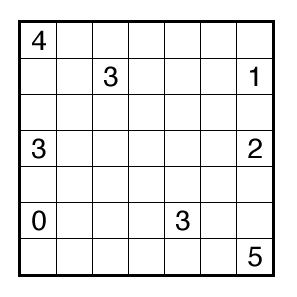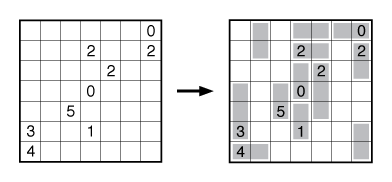Ghost Tren by Murat Can Tonta
This week we are sharing easy sample puzzles from our ebook The Puzzlemasters’ Workshop which showcases six authors exploring new puzzle styles or variations with 8-10 challenges in each section. Today’s post is Ghost Tren.

or solve online (using our beta test of Penpa-Edit tools in Yajilin mode allowing line drawing and cell shading/unmarking; hitting tab can alternate to separate shading and edge drawing modes).
Theme: Clue Symmetry and Logic
Background: Variation of the object placement/object movement puzzle Tren, with new rules that allow for unclued “ghost” blocks and require overall connectivity of white cells. This specific variation with both new rules was originally created by Murat Can Tonta in 2012 but explored much more fully here as an extension of the original Tren.
Rules: Locate some train cars in the grid having size 1×2 or 1×3. Each number in the grid should be part of a car, indicating the number of unoccupied cells the car can move to by traveling along its longest axis. No more than one number can be in a train car; cars can also be placed without any numbers, with no restrictions on their ability to move. All unused cells must be part of a single connected group.
Example by Thomas Snyder:

(No official times or solution entry for this week; just click “SOLVE?” when finished.)
Solution: Last page of PDF
Note: More Ghost Tren puzzles can be found in The Puzzlemasters’ Workshop.

I am really enjoying the Ghost Tren puzzles in the e-book. Would love to see more of this puzzle type.
Hello! Hearing that makes me very happy. I hope to make some more soon.
I’ve been trying the sample here and I’m not sure what I’m doing wrong. Has it been tested for solvability?
Yes, it is a uniquely solvable example. It is not very easy necessarily, but should be solvable if you understand the written rules fully.
SPOILERS!
Please delete if this violates the rules.
https://www.flickr.com/photos/34561227@N05/49067753042/
That is as far as I can get.
This is close, but you have isolated a white cell (R6C7 is white and is not connected by edges to the other white cells so that they are part of one group). The large gray block going vertically in column 6 is not part of the solution.
I am aware of the isolated white cell which is why I knew that was not the solution. Thanks to your clue I saw I what I was doing wrong. It was a mistake that was hard to spot.